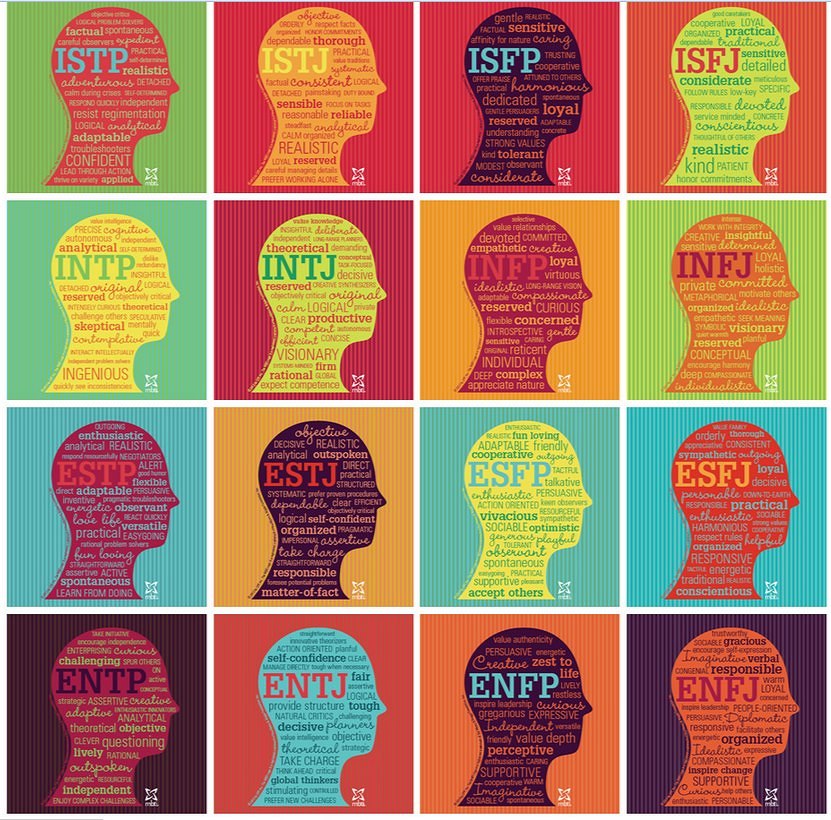Myers-Briggs Personality Types

I first stumbled upon the Myers-Briggs Type Indicator test (MBTI) in my freshman year of college back when I originally majored in Psychology. One of my professors introduced it to my class. Ever since I took it, all I wanted to do was study it more in depth. I wanted to know more than just the cookie cutter descriptions of each personality type often provided. I began learning everything I could about the 16 personality types on forums, blogs, and websites. Ranging from their career preferences and love compatibility, to even something as silly and random as fictional characters and what they typed as. Perhaps it’s because all I wanted were answers at a time when I was still trying to figure out who I was. And how I fit into this large puzzle we call society.
If you read my previous article (Navigating My Ideal Future As An INFP), you’ll know that I’m tested as an INFP, or more specifically an INFP-T. One of the creators of the MBTI, Isabel Myers, is also an INFP. Isabel’s mother, Katharine Briggs, became interested in researching the personality type theory with her, too. When she met Isabel’s husband Clarence, Briggs was intrigued by the differences in Clarence and Isabel’s personalities and perspectives of the world. Briggs realized how similar and closely linked their research in 1943 was compared to Carl Jung’s Psychological Types published in 1921. Still to this day, the MBTI test is a popular instrument for helping people understand and get along with one another. Whether it be in the workforce or in marital counseling. You can take the MBTI test here.
Although each personality type briefly consists of five letters, there is so much intricate self-discovery involved in each aspect they represent. The first letter you’ll type as is either “I” or “E.” “I” stands for introversion and “E” stands for extroversion. Introverts focus more on concepts and ideas, preferring to spend time in their inner worlds than the outside world. Because of this, they need significantly less external stimulation than extroverts. Instead of trying to change the world, they’re more concerned with trying to understand it. They work better in solitude and prefer activities and hobbies with depth over breadth.
Extroverts, on the other hand, get their energy from looking outwards, exploring all that is around them. They like variety and are very action-oriented. Extroverts want to make a difference in the world and like working with others in teams. They prefer breadth over depth in everything they do and act before thinking. As a result, extroverts may consider introverts to be passive and egocentric; whereas, introverts may find extroverts to be shallow and pushy. But the differences simply lie in the way each personality type gets energy.
The second letter you’ll type as is either “N” or “S.” “N” stands for intuition and “S” stands for sensory. This part of the personality type determines how you perceive the world and what information you focus on. Intuitors, like me, rely on the visionary. We like ideas and are more comfortable delving into the abstract and what-if’s of life. Imagination and dreams feed us. As a result, we remain more detached from the world than sensors because possibilities keep us fueled more than the actual experience. Intuitors would rather give up the comfort and convenience of everyday modern life to explore a newfound mystery.
Sensors like to focus on the world and what happens around them. They like using their five senses to experience things instead of relying on theories. They have a better time living in the moment and focusing on the present instead of pondering over the possibility of something. Sensors do better with facts and concrete information instead of exploring ideas and the abstract. They also do better focusing on one thing at a time instead of multi-tasking. Sensors prefer to communicate about concrete matters and real life experiences. Intuitors like to talk about ideas and read between the lines.
As a result, sensors and intuitors might have a difficult time understanding each other. Sensors can easily mistake intuitors for being naive and absentminded while intuitors can find sensors to be materialistic, unimaginative, and simplistic. Neither, however, is true, for this is just the way each personality type functions and makes sense of the world.
The third letter you’ll type as is either “F” or “T.” “F” stands for feeling and “T” stands for thinking. This part of our personality type determines how we make decisions and cope with emotions. Thinkers are rational and logical-minded, relying on their head instead of their heart. Thinkers are just as emotional as feelers, but they prefer to override their feelings with logic. Feelers, on the other hand, are emotionally driven and care very little about hiding them. Feelers believe that emotions are important and that we shouldn’t be afraid to follow our hearts. They prioritize cooperation over competition. Because of these differences, thinkers often prefer to climb the social ladder whereas feelers prefer careers that line up with their own personal core values.
The fourth letter you’ll type as is either “P” or “J.” “P” stands for perceiving and “J” stands for judging. Judgers like to make plans and stick with them. They prefer clarity and closure. Thus, they are more likely to make mental checklists, checking things off as they go along. Whether it be groceries they need to buy or goals for their future. Judgers have a very strong work ethic and prioritize their responsibilities. They also like abiding by rules and the law.
Perceivers, on the other hand, are more flexible and go with the flow when dealing with challenges and the unexpected. They like searching for opportunities and possibilities and don’t like to commit until they’ve explored multiple options. Perceiving types prefer to do what makes them happy instead of what their parents, teachers, or employers tell them what they should do. Although perceiving and judging types are the exact opposite of each other, often in romantic relationships, when P’s and J’s come together, they can balance each other out. They learn to challenge one another with these differences.
Although some may argue that it seems impossible to narrow personalities to just sixteen types, remember that the test provides a spectrum. So people who identify as an introvert, for instance, can in fact be an ambivert. It depends on the small percentage of introversion that overrides their score on extroversion. The accuracy of your test results also heavily rely on how honest you are when answering the questions. At the end of the day, the MBTI is just a theory, but one I’ve found to be helpful when understanding how people function overall.
What’s your MBTI? Did you find the test to be helpful? Leave a comment down below!
References
Energy: Intuitive vs. Observant. (2011). Retrieved June 7, 2017.
Extraversion vs. Introversion. (2002). Retrieved June 7, 2017.
Free Personality Test. (2011). Retrieved June 7, 2017.
Identity: Assertive vs. Turbulent. (2011). Retrieved June 7, 2017.
Nature: Thinking vs. Feeling. (2011). Retrieved June 7, 2017.
Tactics: Judging vs. Prospecting. (2011). Retrieved June 7, 2017.
The History of the MBTI Assessment. (2017). Retrieved June 7, 2017.
Edited by Viveca Shearin



[…] is one of the oldest outdated personality archetype. Nowadays, more reliable tests are the MBTI or The Big Five Personality […]